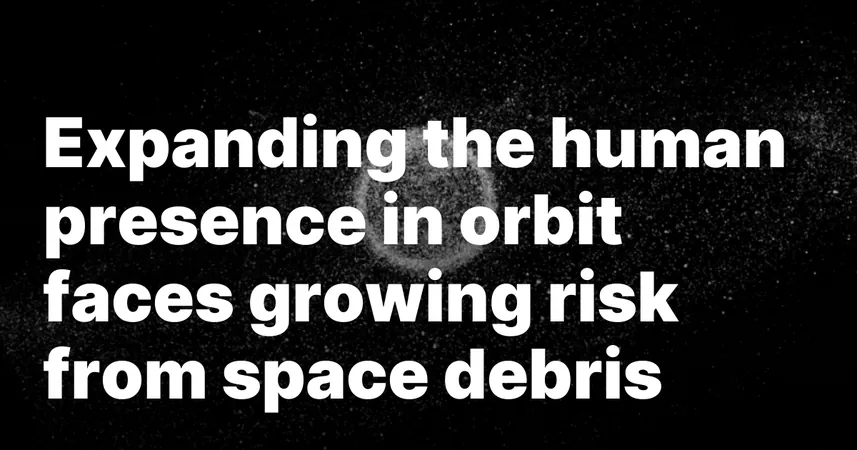
Space Debris: The Major Threat to Expanding Human Operations in Low Earth Orbit!
2025-05-01
Author: Yu
As we stand on the brink of a significant leap in human presence in Low Earth Orbit (LEO), a hidden menace looms large: space debris. The remnants of past missions threaten to turn our quest for deeper exploration into a perilous endeavor.
With the International Space Station (ISS) slated for retirement by 2030, innovative commercial space stations like Starlab, Orbital Reef, Axiom Station, and Haven-1 are gearing up to fill the void. Meanwhile, SpaceX's Crew Dragon remains a vital lifeline, shuttling astronauts to the ISS and beyond. Upcoming missions like Fram2 and Axiom Mission 4 are already showcasing the vast prospects ahead, even hinting at Starship becoming an orbital research hub.
The Junkyard in Space: A Collision Course Ahead!
However, the chaotic landscape of space junk casts a shadow over these advancements. More than half of all collision hazards in LEO can be traced back to debris—ranging from defunct satellites to tiny fragments created by destructive events like explosions and anti-satellite tests. Alarmingly, in the last five years alone, the ISS had to maneuver away from potential collisions a staggering 14 times!
As we embrace more private space stations and crewed missions, the risk of catastrophic collisions spikes. To mitigate this, a multipronged strategy is essential: from preventing new fragments to enhancing detection systems for smaller debris, the need for action has never been more urgent.
Preventing Satellite Breakups: A Critical Move!
Unplanned satellite breakups are prime culprits in creating hazardous debris fields. The main triggers—power anomalies, propulsion failures, and structural fatigue—must be tackled through stricter satellite design and lifecycle management. A crucial focus should be on 'passivation'—a protocol that limits energy reserves in defunct satellites to avoid explosions.
Moreover, incidents like battery explosions remain overlooked danger zones. History has shown that lithium-ion batteries, if not properly managed, can lead to devastating debris events. Therefore, rigorous end-of-life planning and ground operator training are paramount.
Launches on the Rise: A Debris Dilemma!
The surge in space launches compounds the risks of debris generation. While U.S. companies like SpaceX and Rocket Lab have improved satellite deorbit practices, regulatory gaps allow many spent rockets to linger in our orbit for years. The Federal Aviation Administration has proposed a new rule for timely deorbiting, yet a five-year timeline is crucial for real change.
Global coordination is vital; nations like China and Russia must adopt stringent measures as well, especially given China's emerging megaconstellations which pose an escalating threat.
The Tiny Threat: Small Debris, Big Damage!
Objects smaller than 10 centimeters are particularly treacherous, evading current tracking systems. At speeds of around 7.8 km/s, even tiny debris can wreak havoc. For instance, a small fragment can deliver energy equivalent to a hand grenade, endangering spacecraft and astronauts alike.
Efforts are in motion to enhance tracking capabilities, but substantial investment in better sensors and advanced algorithms is necessary. Ignoring this fight against small debris could spell disaster for future missions.
The Race for Debris Cleanup: A Race Against Time!
With over 3,000 abandoned satellites and thousands of rocket bodies cluttering orbits, the imperative for active debris removal (ADR) is undeniable. Current technologies show promise but are languishing in the demonstration phase. Programs like Astroscale's ELSA-d and NASA's Active Debris Removal Vehicle are paving the way for effective removal operations.
Incentives from the U.S. government could catalyze progress in this domain, possibly adopting a "debris-as-a-service" model to enhance commercial engagement in cleanup efforts.
As we gear up for a new era of orbital activity, addressing these debris-related challenges is vital for the safety and sustainability of our burgeoning space ambitions!


 Brasil (PT)
Brasil (PT)
 Canada (EN)
Canada (EN)
 Chile (ES)
Chile (ES)
 Česko (CS)
Česko (CS)
 대한민국 (KO)
대한민국 (KO)
 España (ES)
España (ES)
 France (FR)
France (FR)
 Hong Kong (EN)
Hong Kong (EN)
 Italia (IT)
Italia (IT)
 日本 (JA)
日本 (JA)
 Magyarország (HU)
Magyarország (HU)
 Norge (NO)
Norge (NO)
 Polska (PL)
Polska (PL)
 Schweiz (DE)
Schweiz (DE)
 Singapore (EN)
Singapore (EN)
 Sverige (SV)
Sverige (SV)
 Suomi (FI)
Suomi (FI)
 Türkiye (TR)
Türkiye (TR)
 الإمارات العربية المتحدة (AR)
الإمارات العربية المتحدة (AR)